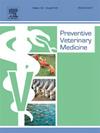牛黑斑病:使用贝叶斯潜类模型方法和疾病的临床特征评估三种不同测试的诊断准确性。
IF 2.4
2区 农林科学
Q1 VETERINARY SCIENCES
引用次数: 0
摘要
牛绒毛膜病是一种由组织囊肿形成的牛绒毛膜复合体引起的疾病,在欧洲重新出现,导致健康和生产受到严重损害,并造成经济损失。疾病的早期发现对于实施有效的控制措施至关重要,但由于缺乏具体的早期临床症状,这是一项挑战。本研究的目的是:1)估计在自然暴露的牛(皮肤组织病理学(HIS-SK))中检测贝氏杆菌的三种检测方法的诊断准确性;PCR-skin (PCR-SK);以及使用贝叶斯潜类模型(BLCM)对鼻和巩膜结膜拭子进行平行PCR (PCR- ns - sc)和2)来描述所研究动物鼻窦炎的临床表现。这项研究涉及54头成年利穆赞牛。生物安全措施的评估和评分为中等。在临床检查中,在急性期结束和慢性期开始之间诊断出一种形式的肝硬化。此外,29只动物表现出亚临床感染,其特征是存在巩膜结膜囊肿。PCR-SK和PCR-NS-SC均能检出贝氏杆菌。评价PCR-SK、PCR-NS-SC和HIS-SK的诊断性能。BLCM表明HIS-SK特异性最高(99.1 %、95 %后验概率区间PI: 96 - 100年 %),而PCR-SK和PCR-NS-SC证明更高的敏感性(91.0 % 95 %π:68 - 100 %,和85.0 %,95 % PI: 67 - 100 %,分别)。该研究的结论是,使用平行PCR-NS-SC可能是早期检测牛粪螺旋体的可行替代方法,为牛群水平监测和控制牛粪螺旋体病提供了一种侵入性较小的方法。本文章由计算机程序翻译,如有差异,请以英文原文为准。
Bovine besnoitiosis: Assessment of the diagnostic accuracy of three different tests using a Bayesian latent class model approach and clinical characterization of the disease
Bovine besnoitiosis, a disease caused by the tissue cyst-forming apicomplexan Besnoitia besnoiti, is re-emerging in Europe, leading to significant impairment of health and production, as well as economic losses. The early detection of the disease is of the utmost importance for the implementation of effective control measures, yet this is a challenge due to the lack of specific early clinical signs. The objectives of our study were 1) to estimate the diagnostic accuracy of three tests to detect B. besnoiti in naturally exposed cattle (histopathology-skin (HIS-SK); PCR-skin (PCR-SK); and parallel PCR of nasal and scleroconjunctival swabs (PCR-NS-SC)) using a Bayesian latent class model (BLCM) and 2) to describe the clinical presentation of besnoitiosis in the studied animals. The study involved 54 adult Limousin cattle. Biosecurity measures were assessed and scored as medium. At clinical examination, a sire was diagnosed with a form of besnoitiosis between the end of the acute phase and the beginning of the chronic phase. Furthermore, 29 animals displaying a subclinical infection, characterized by the presence of scleroconjunctival cysts, were identified. The PCR-SK and PCR-NS-SC were able to detect B. besnoitia. The diagnostic performance of PCR-SK, PCR-NS-SC and HIS-SK was evaluated. The BLCM indicated that HIS-SK had the highest specificity (99.1 %, 95 % posterior probability interval PI: 96–100 %), while PCR-SK and PCR-NS-SC demonstrated higher sensitivities (91.0 %, 95 % PI: 68–100 %, and 85.0 %, 95 % PI: 67–100 %, respectively). The study concludes that the use of a parallel PCR-NS-SC could represent a viable alternative for the early detection of B. besnoiti, providing a less invasive method to monitor and control bovine besnoitiosis at the herd level.
求助全文
通过发布文献求助,成功后即可免费获取论文全文。
去求助
来源期刊

Preventive veterinary medicine
农林科学-兽医学
CiteScore
5.60
自引率
7.70%
发文量
184
审稿时长
3 months
期刊介绍:
Preventive Veterinary Medicine is one of the leading international resources for scientific reports on animal health programs and preventive veterinary medicine. The journal follows the guidelines for standardizing and strengthening the reporting of biomedical research which are available from the CONSORT, MOOSE, PRISMA, REFLECT, STARD, and STROBE statements. The journal focuses on:
Epidemiology of health events relevant to domestic and wild animals;
Economic impacts of epidemic and endemic animal and zoonotic diseases;
Latest methods and approaches in veterinary epidemiology;
Disease and infection control or eradication measures;
The "One Health" concept and the relationships between veterinary medicine, human health, animal-production systems, and the environment;
Development of new techniques in surveillance systems and diagnosis;
Evaluation and control of diseases in animal populations.
 求助内容:
求助内容: 应助结果提醒方式:
应助结果提醒方式:


